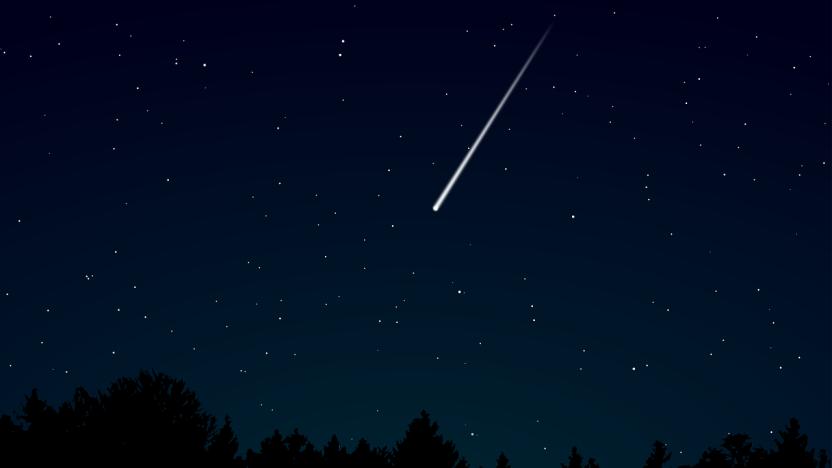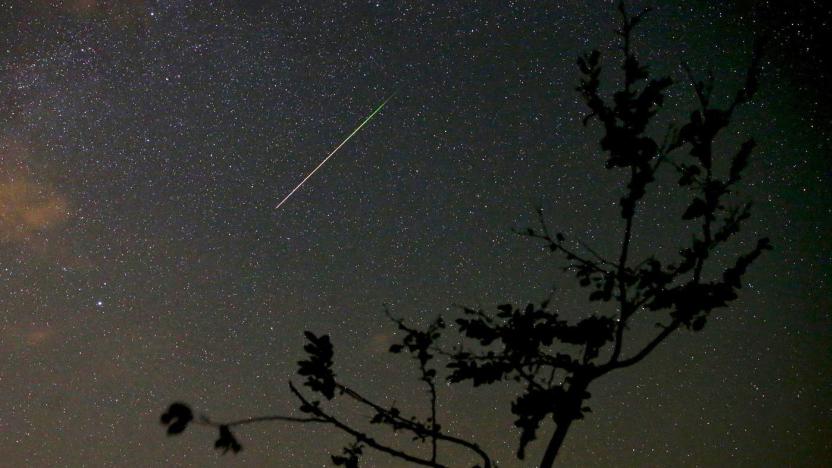meteor
Latest

Astrophysicist who claimed to find alien tech may have done the science wrong
Last month, theoretical physicist Avi Loeb made headlines with the sensational claim that tiny spherules recovered from the bottom of the ocean were probably of alien origin. “It’s most likely a technological gadget with artificial intelligence,” he said to The New York Times, which published a story today about the Harvard professor’s contentious claims. Although the biggest scientific breakthroughs often start with a bold hypothesis, Loeb’s peers believe the decorated astrophysicist’s assertions can be called many things — but “good science” isn’t one of them.

Artificial meteor shower displays are coming
Fireworks. So passé, right? That could well be the thinking of one Japanese start-up, which is developing shooting stars on demand, and plans to put on the world's first artificial meteor shower in early 2020.

Optical laser uses shockwaves to peer inside distant planets
Scientists at SLAC's National Accelerator Laboratory are able to peer even further into space thanks to an improved optical laser. The laser uses shockwaves to create high pressure conditions in materials, and the material's response is then captured by an ultra-bright X-ray laser, revealing what's going on inside planets and meteors. Upgrades to the optical laser means it's now three times more powerful, with the equivalent power of 17 Teslas discharging their 100 kilowatt-hour batteries in a single second.

France creates a meteor-tracking camera network
It's difficult to track where meteors go when showers are both relatively common and rain down loads of space rocks. However, France thinks it has the answer. It recently launched FRIPON, a meteor detection network. The system uses a country-wide camera system (currently 68, scaling up to 100) to track where meteors fly -- if two or more cameras spot something, scientists get an alert. Eventually, that camera data will help narrow down likely impact areas (as small as 1 kilometer, or 0.6 miles) and send thousands of volunteers out to recover meteorites.

Russia has plans to nuke Earth-bound asteroids, if necessary
From 2012 to 2015, Russia researched ways of deflecting Earth-bound asteroids using nuclear weapons and came up with a best-case scenario, The Telegraph reports. The Central Scientific Research Institute of Machine Building, an arm of Russia's state-run Roscosmos space agency, worked on the asteroid problem with other countries (including the United States) in a program called NEOShield, which was largely funded by the European Commission. Note that "NEO" in this case stands for "Near-Earth Object," not The One you're probably imagining.

DNA smeared on a rocket survives re-entry and tells of life's origins
Well, would you look at that: scientists have discovered that DNA can make it through the hellish ordeal of atmospheric re-entry after all. German and Swiss researchers dotted a rocket's grooves and screw heads with fragments of genetic blueprints to see how they'd fare in situations that could've led to the appearance of life on Earth. Scientific American notes that the 13-minute rocket trip might not perfectly represent how DNA might actually travel from one celestial body to the next (that'd be by meteor), but there is purpose here. What the experiment suggests is that even if the meteor's been scorched, that the material can survive at higher temperatures than previously expected, and as such this paints a better picture of just how resilient DNA is. What's next? Pushing the limits further and seeing exactly what it takes to kill the double helix -- we're pretty sure at least one rock band is itching to find out. [Image credit: Getty Images/OJO Images RF]

The Perseid meteor shower returns, peaks Sunday and Monday nights
Hey nerds, get some fresh air this weekend: there's gonna be hunks of burning rock falling from the sky. Image courtesy of Roberto Porto

Burning Legion begins Russian invasion
Alright, you got us -- this event has nothing to do with World of Warcraft. However, the tweet below from Tankspot's Lore was too sweet to pass up. So apparently the Burning Legion is invading Russia... ow.ly/hJI1P - Josh Allen (@devolore) February 15, 2013 For those of you unaware, late last night (around 9 a.m. local time where the event occurred), a meteorite fell to Earth in the Russian Ural Mountains. It created a brilliant light show in the sky, leaving a heavy white contrail in its wake and reportedly exploding at an altitude of 10,000 meters (32,800 feet.) The shockwave of the meteor's explosion caused surface-level damage, resulting in over one hundred individuals calling for medical assistance due to injuries sustained from broken glass and other shrapnel. The number of reported injured continued to rise throughout the night, up to 400 less than two hours after impact. A zinc factory in the area also suffered heavy damages: the shockwave cause 6,000 square feet of roofing to collapse. If you're curious what such an impact might sound like, you're in luck. And here's another for good measure.

Meteorite shower crashes into Russia (video)
A meteorite shower has crash landed across Russia's Ural region, injuring over 250 900 people and damaging buildings in six cities. Residents in Chelyabinsk reported shaking ground, windows shattering and car alarms going off as the rocks fell to Earth. Officials in the country say that the shower began after a larger meteor disintegrated in the lower atmosphere, causing the fragments to wreak the (currently) non-lethal havoc. If you'd like to compare how wrong (or right) Michael Bay got it in Armageddon, head on past the break for some footage.

Ireland completes spectrum auction after analog shutoff, LTE rollout pegged for mid-2013
The dust has settled after Ireland's recent spectrum auction, and wouldn't you know it, Vodafone, O2, Meteor and Three have picked up a combined 140MHz of paired spectrum across the 800, 900 and 1800MHz bands. According to the country's regulator, ComReg, the auction will effectively double the spectrum available in these bands and will allow for LTE deployment across Éire. For its part, O2 has committed to begin its 4G rollout in the first half of 2013. To ensure quick deployment, all license holders are required to make their new spectrum available to 70 percent of Ireland's population within three years. In all, the companies will pay €855 million ($1.09 billion) for spectrum rights until 2030, of which, €482 million is payable up front. Curiously enough, the country's 800MHz spectrum was freed up just last month after its analog shutoff. To find a complete breakdown of the situation, feel free to hit up the announcement from ComReg at the source link below. [Thanks, Neil] [Photo credit: Seattleye / Flickr]

NASA developing tractor beams, no plans for Death Star... yet (video)
Fully functional LightSabre aside, a tractor beam has to be high on most geek wish-lists; lucky for you NASA has started working on one. Before you drop your sandwich (or whatever that object in your left hand is), this won't be for sucking up star cruisers, but the more modest task of sample and space dust collection. The basic concept has already been proven, but now NASA's Office of the Chief Technologist has given boffins $100,000 to make the dream a reality. Three potential methods are already on the table, which in lay-terms resemble laser tweezers, a light vortex and a conceptual rippling beam. Once developed, it could signal the end of traditional mechanical sample collecting -- and just plain luck -- consigning robotic arms to the history books. Check the video after the break for science-tastic mock up of how it might work.

Space radar captures echoes of Perseid meteor shower (video)
We all know lasers make a "pew pew" sound, but shouldn't there be a sound effect button for high-speed burning meteors? Well, the US Air Force Space Surveillance Radar in Texas just recorded its own, capturing echoes of the Perseid meteor shower last Friday night. Every year, the Earth orbits directly into a cloud of debris from the Swift-Tuttle comet, which burn up as they fly through the atmosphere at a staggering 133,200 mph. Similar to the sound of a lightsaber slicing through the air, they make some pretty sweet sound effects -- perfect for your next auto-tune experiment. Check out the audio with some ISS pics thrown in for good measure after the break.

DARPA's new Space Surveillance Telescope will keep our satellites safe from interstellar debris
What's that in the sky? A bird? A plane? Oh, it's just some junk floating around in space, posing major threats to our military's spy satellites. To help keep an eye on it, engineers at DARPA, MIT and the Air Force have unleashed a new $110 million telescope that's been in the works for nine years now. The new Space Surveillance Telescope (SST) is capable of delivering wide-angle views of the Earth's firmament thanks to a curved CCD. This allows for a massive 3.5m aperture and f/1.0 exposure settings, capturing more light in a day that your average scope can in a week. As part of the Air Force's Space Surveillance Network (SSN), the telescope's primary task will be to look out for any microsatellites, meteors or other alien droppings moving at the same speed at which the Earth rotates. The system developed its first images earlier this year and the Air Force may eventually place SSTs all over the world, creating a 360-degree surveillance blanket and going a long way toward keeping our spycraft warm, cozy, and safe from galactic hazards.

Samson Meteor Mic review
Look at this guy! What a cutie! It's like Elvis' microphone cross-bred with some sort of weird alien USB bumblebee. Samson's Meteor Mic is unquestionably shiny, but its competition is an increasingly attractive bunch as well. Does Lil' Samson's beauty run only grill-deep? Read on to find out! %Gallery-122022%

Heavens herald the arrival of the Wii
Okay, Nintendo. You've gotten millions of hardcore gamers excited for your new, upcoming system. You've already managed to convince people who have never even held a game controller to invest in your product. But now, you're really done it. The skies themselves are clamoring for a new Nintendo Wii.Check this: at approximately 11:45 PM on Saturday, November 18th, there will be an brief yet intense meteor shower easily visible from the eastern coast of the United States. So long as the night skies are crisp and clear, all those people camping out should be able to enjoy the show. The cause? Leonid meteors caused by dust left by the small comet Temple-Tuttle will strike the Earth's atmosphere, incinerating in flashes of bright light.We know not if the Wii is celestial in nature, but it's one hell of a coincidence. Wii-lovers and star-gazers alike, here comes launch day.[Thanks, Brent!]











